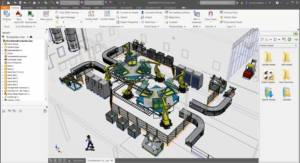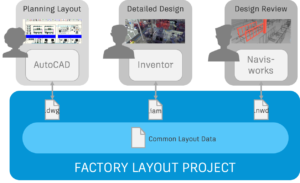Workflow Improvements for Inventor and Factory Design Utilities

Why talk about the Factory Design Utilities on the Inventor Blog? Inventor plays a key role in helping users design and build their factories. It is used to define factory layouts, to design much of the industrial machinery installed in the factory, and it is used to do the detailed integration of the equipment to the building. It is also part of a connected set of tools and workflows. The other utilities provide capabilities for process modeling and simulation, rough layout using AutoCAD and design review and project sequencing using Navisworks. Together these four tools help manufacturing users design and optimize their production environments. For 2020 we have made significant improvements to the way these tools work together making them simpler to use and easier to manage factory projects.
Figure 1. Factory Design Utilities for Inventor.
DATA MODEL IMPROVEMENTS
In the 2020 release, we have changed the data model to work very differently than in previous years. When using the Inventor utilities (or any other FDU), users navigate to the desired factory layout and open. Inventor will read the .iam file and another common file that describes the factory project data for all the utilities. These two files are compared to determine if the .iam is current or not. If an .iam file does not exist, the utility will create one from the common project data file. If the .iam is out of date, it can be updated using the common project data file as a reference. Each of the utilities in AutoCAD, Inventor, and Navisworks perform this action meaning that users only need to install the tools they require for their job. Users don’t need all the Factory Design Utilities tools to take full advantage of workflow for the project.
Figure 2. Factory Project data architecture.
WHY THE NEW DATA MODEL MATTERS
Factory Design Utilities 2020 makes it easier than ever to access and manage Layout project data. Layout project data can be stored locally, on a network drive or in Vault providing flexibility for your team’s needs. Probably the most impactful benefit is eliminating the requirement to install all the tools to use Factory Design Utilities. If you are only responsible for the integration of equipment to the line and building, Inventor is all you need. You don’t need AutoCAD or Navisworks to complete “sync” workflows. The last benefit of this change is more subtle. This data model dramatically simplifies the effort required to integrate new tools into this ecosystem. The APIs for Factory Design Utilities are exposed allowing integration with other applications in the manufacturing environment.
BIGGER PICTURE
The longer-term view for Factory Design Utilities is that we need to broaden the workflow to include many additional capabilities. Customers need access to specialized capabilities for factory planning and optimization that benefit from using Factory Design Utilities data. This new data at the center architecture makes that possible by allowing adjacent capabilities to read and write to the factory project data, in effect extending the capability ecosystem well beyond what Autodesk can provide alone. We are actively pursuing a handful of partnerships that demonstrate making this ecosystem work.
We are really excited about the improvements delivered in the 2020 release and look forward to hearing your stories about how you have put them to the test!
Ryan McMahon
Sr. Product Manager
Ryan has been a Sr. Product Manager for Autodesk for 8 years and has broad experience in manufacturing, product management, product development and strategic planning. He has an MBA from the University of Washington, a B.S. in Electrical Engineering from Washington State University and holds 3 patents.
The post Workflow Improvements for Inventor and Factory Design Utilities appeared first on Inventor Official Blog.
Industries


Sign Up to get our monthly news Letter
About Us
All Rights Reserved | Mitchell and Son Additive Manufacturing Ltd | Registered Company in England and Wales | Company Number : 12038697
| Public Liability Insurance no. 14615097
Insurer: AXA XL













